Iron Age - Available - Photo gallery
Image database with photographs of ancient art and antiquities
Our image database provides photographs of ancient art and antiquities for press releases as well as for private use. All artefacts sold in our gallery are documented through professional photographs. The resulting image library contains numerous ancient Egyptian, Greek and Roman antiquities as well as ancient coins. The time span from Stone Age, over Bronze Age and Classical Antiquity until Late Antiquity is covered.The photo gallery aims at providing a vast visual archive equipped with filters and search tools. You are most welcome to search the constantly growing number of artefacts in the image library. We are also happy to authorize hyperlinks from your webpage / forum to the objects depicted in our gallery. For this purpose, please send us a short notification prior to placing a hyperlink. For almost every object high definition photographs are available and can be provided e.g. to document your collection or for scientific papers or popular science articles. If you are interested in using pictures for publications, print media or other purposes, please contact us and we will be happy to assist you.
-
 Horse bit from Luristan
Horse bit from LuristanDelightful artefact attesting the dawn of horse breeding in Western Iran during the 8th century BC. Two joined triangles form the cheek pieces.
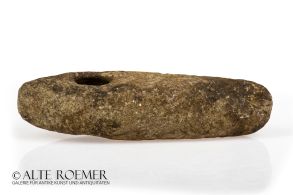 Neolithic axe head
Neolithic axe headThe strong blade was probably used for a battle axe. Crafted from grey rock. An artefact from the Neolithic Age of Europe.
 Sword from the Hallstatt period
Sword from the Hallstatt periodImpressive bronze weapon from the Early Iron Age around 700 BC. Made in the region of today's Germany or surrounding countries.
 Rare plastic Roman oil lamp part shaped as Priapus
Rare plastic Roman oil lamp part shaped as PriapusFigure of Priapus, god of fertility and protector of male genitalia, as bearded older man in heavy robes, his hands exposing his phallus.
 Egyptian glass inlay in face shape
Egyptian glass inlay in face shapeThe flat relief made of red glass paste served as an inlay and decorative element in the Ptolemaic period. It was combined with a headgear and body inlay.
 Tall idol of the Mezcala culture
Tall idol of the Mezcala cultureThe highly stylized figure of a man in museum-worthy condition. Made from beautifully grained andesite. Late Preclassic of Mesoamerica.
 Roman glass mosaic bowl
Roman glass mosaic bowlNice little bowl with mosaic glass eyes on blue and green background. Exhibited and published in the 1980ies. Made in the early Roman Imperial period in the province of Syria.
 Roman gold ring with intaglio
Roman gold ring with intaglioThe beautiful ring from Roman Imperial times is decorated by an intaglio of vibrant red carnelian stone. It shows the god Hermes.
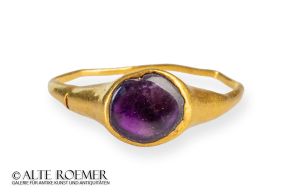 Roman gold ring with amethyst
Roman gold ring with amethystThe finger ring from the Roman Imperial period is decorated with an insert made of beautiful, purple stone.
 Roman gold necklace with beads
Roman gold necklace with beadsThe necklace impresses by its wonderful condition, including the original agate beads. Probably from the Roman province of Moesia. 100 to 250 AD.
 Limestone figure of a concubine
Limestone figure of a concubineFigure of a woman on a support, her arms and hands close to her sides. Originating from ancient Egypt.
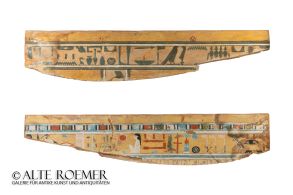 Fragments of an Egyptian coffin lid
Fragments of an Egyptian coffin lidMagnificently preserved, polychrome hieroglyphs from the 12th Dynasty. A prime example of the strict yet energetic art of the Middle Kingdom. With attribution by Professor Settgast of the Egyptian Museum in Berlin from 1979.
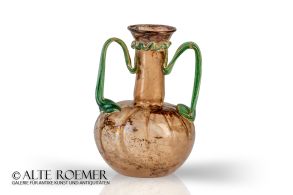 Roman glass bottle with handles
Roman glass bottle with handlesThe glass impresses with its size and elegant shape. Made in one of the Roman glass factories in the eastern Mediterranean during the Late Imperial period.
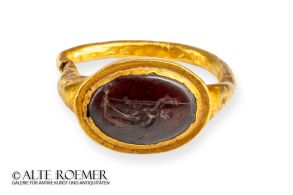 Roman gold ring with intaglio
Roman gold ring with intaglioThe finger ring from Early Roman Imperial times is decorated by an intaglio of vibrant red carnelian stone.
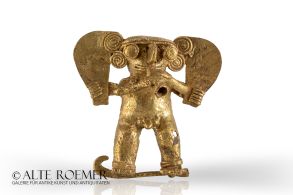 Gold figurine of an eagle from Colombia
Gold figurine of an eagle from ColombiaMagnificent example of the pre-Columbian Tairona culture, which produced the most impressive gold works of ancient America. In mythology, the eagle brought the seeds for one of the main crops, cassava. Made between 900 and 1550 AD.
 Phoenician eye bead
Phoenician eye beadPolychrome glass bead with stylized elements of a face as protection against the evil eye. Produced in Carthage or the Phoenician homeland, 4th to 3rd century BC.
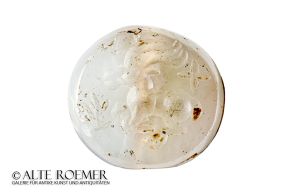 Sasanian stamp seal
Sasanian stamp sealVery nice dome-shaped seal made of stone. The piece is from the period of Sasanian rule in the Near East.
 Sasanian stamp seal
Sasanian stamp sealVery nice dome-shaped seal made of stone. The piece is from the period of Sasanian rule in the Near East.
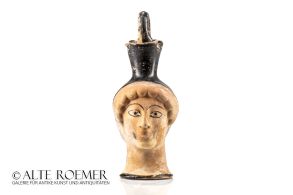 Athenian vase in the shape of a woman’s head
Athenian vase in the shape of a woman’s headExcellent condition, body and even the fragile handle undamaged. Ex October 30th, 1983 auction Pierre Yves Clavel, Marseille, France, Lot Nr. 83.
 Roman sprinkler
Roman sprinklerPerfume bottle with pattern-blown body. An aperture made it easy to dispense the precious content drop by drop. Made in the Roman province Syria in the 3rd cent. AD.
 Mosaic glass inlays and spindle whorls
Mosaic glass inlays and spindle whorlsNice group of polychrome inlays and spindle weights from Roman Egypt. Including two fragments with a wonderful floral decor.
 Gold figurine of a quadruped from Colombia
Gold figurine of a quadruped from ColombiaBeautiful small gold figure from the pre-Columbian Quimbaya culture, made by lost wax casting around 1000 years ago.
 Pre-Columbian gold earrings from Colombia
Pre-Columbian gold earrings from ColombiaMatching pair of gold earrings from the Zenú culture. Dating to the 1st millennium. Elegant gold jewellery, once worn as earrings by the Zenú people.
 Very rare Merovingian gold tremissis in perfect condition with known finding location
Very rare Merovingian gold tremissis in perfect condition with known finding locationSo-called "Mint and Moneyer" series, moneyer: Rignicharius.Found 2021 in Horncastle, UK.

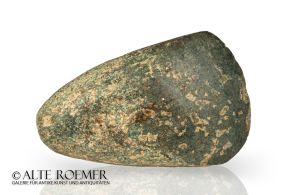

 Magnificent neck ring from Greece
Magnificent neck ring from GreeceThe solid bronze ring is beautifully decorated with spiral grooves and punched decoration. An impressive piece from the Iron Age. With expertise from 1987.
 Pre-Columbian mask of the Colima
Pre-Columbian mask of the ColimaExpressive and life-sized face mask from the Early Classic period of Mexico. From the museum collection of Washington University.
 Four Scythian arrow heads
Four Scythian arrow headsGroup of four arrowheads made of bronze in excellent condition. Popular weapon of the cultures of the 1st Millennium BC.
 Four Scythian arrow heads
Four Scythian arrow headsGroup of four arrowheads made of bronze in excellent condition. Popular weapon of the cultures of the 1st Millennium BC.
 Neolithic sickle from Denmark
Neolithic sickle from DenmarkCrescent-shaped blade made of beautiful brown flint. This tool represents an intermediate state within the radical transition from Neolithic to Bronze Age.
 Minoan stone bowl
Minoan stone bowlElegant vessel from Crete, shaped like a bird's nest, possibly a container for ointments. Dating to the late Minoan period around 1500 BC.
 Sasanian gilt silver bowl
Sasanian gilt silver bowlMagnificent example of Sassanid craftsmanship of the highest quality. With a gilded bas-relief of a dancing woman in the tondo. Ex Sotheby's.
 Sasanian silver bowl
Sasanian silver bowlGood example of high quality Sassanid craftsmanship. Acquired at Sotheby's in 1981.
 Bronze dagger from North Iran
Bronze dagger from North IranShort bladed weapon from Iron Age Iran. It is probably a find from the province of Gilan in northern Iran.

